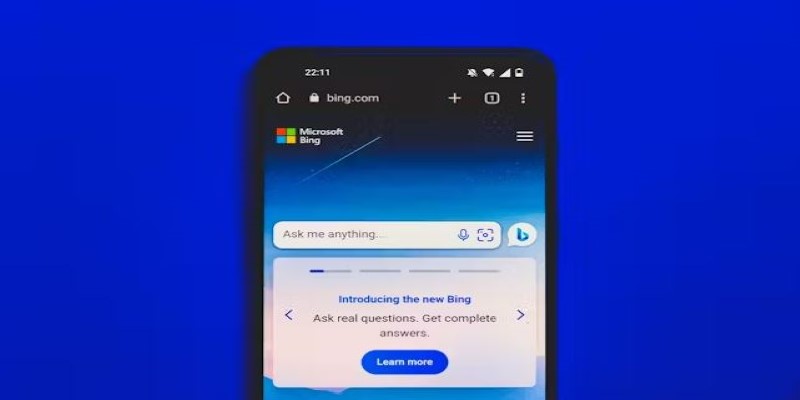Searching for information on a phone has become second nature. But now, Microsoft is changing that experience by bringing Bing's AI-powered search to Android and iOS. Instead of showing lists of links, it now responds like a chatbot, offering direct answers, summaries, and sources in one place. This update reflects a deeper shift: mobile search is moving from keyword results to something more interactive.
It understands context, answers follow-up questions, and works like a conversation. With the new Bing app and Edge browser, Microsoft is placing its AI tools where users need them most—on their phones, in the middle of daily tasks.
How Bing's AI Search Works on Mobile?
When you open the Bing app or use Microsoft Edge on mobile, the familiar search bar is replaced with a conversational interface. At its core, Bing's AI-powered search blends OpenAI's GPT-4 with Bing’s real-time web index. This combination allows it to understand natural language, summarize data from across the web, and respond with more complete answers.
What sets this apart on mobile is how it fits into touch-first behavior. You can type or speak your question, and instead of parsing short keyword inputs, it can handle longer, more conversational queries. Ask it to compare two smartphones, find recipes based on what's in your fridge, or help with a quick language translation—it responds clearly, with citations. The AI format also allows users to continue the conversation in real time, making follow-up questions feel natural rather than like starting a new search every time.
The design takes into account that mobile users want quick, actionable answers. You’re not reading through entire websites on a small screen—you’re skimming, tapping, and expecting instant value. That’s what the AI tries to deliver in one go.
How It Compares to Google’s Mobile Search
Unlike Google, which still leads mobile search volume, Bing has placed the AI experience front and center. Google has introduced generative elements, but they’re experimental and don’t appear for every user or every query. Bing, in contrast, defaults to AI-generated responses when you use the chatbot interface.

In Bing mobile search, you don’t just get AI as a feature—it’s the way search works. When you ask a question, the first result isn’t a link—it’s a synthesized answer, followed by a list of sources you can open if you want to dive deeper. You can tap “continue” and refine or redirect your query without repeating yourself. That continuity makes it feel more like talking to a helpful assistant than flipping through webpages.
Another key distinction is how Bing connects to your Microsoft account. This allows the search to remember your preferences and carry context across sessions. If you’re logged in, you’ll notice that your chat history and past interactions can influence how responses are shaped—something Google’s current mobile search doesn’t really attempt outside of your general activity.
This more personalized flow creates an experience where you spend less time filtering through content and more time interacting with the results directly. The format is efficient without feeling too automated, and that’s what makes Bing mobile search stand out right now.
How People Are Using It Day to Day?
Bing’s AI search fits into daily life by helping people get things done faster without switching between apps. If you're cooking and run out of a key ingredient, you can ask for a substitute and get a direct explanation. If you're comparing hotel options while planning a trip, it can lay out pros and cons without sending you to different sites.
For students, it's becoming a useful study companion, offering quick summaries of articles, simplifying complex topics, or helping brainstorm ideas for essays. Creators and small business owners are using it for help with content drafts, emails, and planning posts for social media.
What makes this especially useful on mobile is how fluid the interaction feels. Voice search works well even with longer prompts, and the results come back in a format that’s easy to read without too much scrolling or clicking. You can copy results into notes or other apps, share summaries, or ask for follow-up ideas on the go.
Rather than replacing traditional search, it complements it, especially in situations where you'd normally bounce between several tabs to get what you need. It works quietly in the background but becomes active the moment you want help solving a problem, organizing information, or just making a decision faster.
What This Means for the Future of Mobile Search
Microsoft’s move to embed Bing's AI-powered search into Android and iOS apps is part of a broader push to change how people interact with online information. As users become more comfortable with chat-based interfaces, the standard search box may start to feel outdated. The change also challenges content creators and websites to focus on clarity and structure, knowing AI tools are now summarizing their pages for mobile audiences.

We’re likely to see more competition soon. Google is testing its own AI responses in mobile search, and Apple is expected to build more intelligence into Siri and iOS. But Microsoft is already live and available, which gives it a head start.
There’s still some risk. As with any generative AI, there’s a chance that responses may sound convincing but contain minor errors. Microsoft tries to address this by including links to source pages with each answer, but users still need to develop a habit of verifying before acting on the information.
This shift also opens the door to more AI-assisted features on mobile. We're seeing signs that Microsoft plans to expand into areas like scheduling, summarizing meetings, or connecting with Microsoft 365 apps. Bing mobile search might be just the beginning of a broader mobile AI assistant strategy.
Conclusion
Bing's AI-powered search on Android and iOS isn’t just a redesign—it’s a rethinking of what search means on a phone. It removes friction by turning your query into a conversation, saving time, and making it easier to follow up. The chatbot approach works especially well on mobile, where users want quick, context-aware help without digging through links. Microsoft has delivered an experience that feels both familiar and new, and it's now setting the pace for what mobile search could look like going forward. For users who want answers fast and in plain language, this AI-first format is already proving useful.











